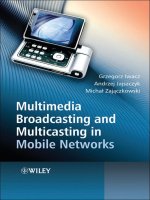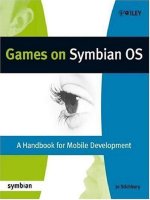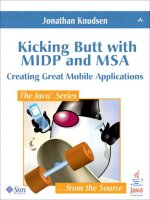Wiley multimedia broadcasting and multicasting in mobile networks nov 2008 ISBN 0470696869 pdf
Bạn đang xem bản rút gọn của tài liệu. Xem và tải ngay bản đầy đủ của tài liệu tại đây (2.26 MB, 213 trang )
Multimedia
Broadcasting and
Multicasting in
Mobile Networks
Grzegorz Iwacz
AGH University of Science and Technology, Poland
Andrzej Jajszczyk
AGH University of Science and Technology, Poland
Michał Zaja˛czkowski
Comarch SA, Poland
A John Wiley and Sons, Ltd, Publication
Multimedia Broadcasting
and Multicasting in
Mobile Networks
Multimedia
Broadcasting and
Multicasting in
Mobile Networks
Grzegorz Iwacz
AGH University of Science and Technology, Poland
Andrzej Jajszczyk
AGH University of Science and Technology, Poland
Michał Zaja˛czkowski
Comarch SA, Poland
A John Wiley and Sons, Ltd, Publication
This edition first published 2008.
© 2008 John Wiley & Sons, Ltd.
Registered office
John Wiley & Sons Ltd, The Atrium, Southern Gate, Chichester, West Sussex, PO19 8SQ,
United Kingdom
For details of our global editorial offices, for customer services and for information about
how to apply for permission to reuse the copyright material in this book please see our
website at www.wiley.com.
The right of the author to be identified as the author of this work has been asserted in
accordance with the Copyright, Designs and Patents Act 1988.
All rights reserved. No part of this publication may be reproduced, stored in a retrieval
system, or transmitted, in any form or by any means, electronic, mechanical, photocopying,
recording or otherwise, except as permitted by the UK Copyright, Designs and Patents Act
1988, without the prior permission of the publisher.
Wiley also publishes its books in a variety of electronic formats. Some content that appears
in print may not be available in electronic books.
Designations used by companies to distinguish their products are often claimed as
trademarks. All brand names and product names used in this book are trade names, service
marks, trademarks or registered trademarks of their respective owners. The publisher is not
associated with any product or vendor mentioned in this book. This publication is designed
to provide accurate and authoritative information in regard to the subject matter
covered. It is sold on the understanding that the publisher is not engaged in rendering
professional services. If professional advice or other expert assistance is required, the services
of a competent professional should be sought.
Library of Congress Cataloging-in-Publication Data
Iwacz, Grzegorz.
Multimedia broadcasting and multicasting in mobile networks / Grzegorz
Iwacz, Andrzej Jajszczyk, Michal Zajaczkowski.
p. cm.
Includes bibliographical references and index.
ISBN 978-0-470-69686-6 (cloth)
1. Multimedia communications—Congresses. 2. Computer networks—Congresses.
I. Jajszczyk, Andrzej. II. Zajaczkowski, Michal. III. Title.
TK5105.15.I83 2008
384.3 3—dc22
2008017686
A catalogue record for this book is available from the British Library.
ISBN 978-0-470-69686-6 (HB)
Set in 11/13pt Sabon by Integra Software Services Pvt. Ltd, Pondicherry, India
Printed in Singapore by Markono Print Media Pte Ltd, Singapore.
To my great brother
Grzegorz Iwacz
To my wife Basia
Andrzej Jajszczyk
To my beloved wife Małgosia and to my parents
Michał Zaja˛czkowski
Contents
About the Authors
xi
Abbreviations and Acronyms
xiii
List of Figures
xix
List of Tables
xxiii
1 Introduction
References
1
4
2 Multicast
2.1 The Idea of Multicast
2.2 Justifying the Cost of Multicast
2.3 Drawbacks of Multicast
2.4 IP Multicast
2.4.1 IP Multicast Networking Procedure
2.4.2 Mobility of Users
References
5
7
9
13
16
18
21
22
3 Internet Protocol Datacasting
3.1 System Architecture
3.2 Digital Video Broadcasting
3.2.1 DVB-T as a Basis for DVB-H
3.2.2 Digital Video Broadcasting Handheld
3.3 Electronic Service Guide
3.4 Streaming
3.5 Data Transmission
3.6 Interaction Channel
References
23
25
28
29
30
40
43
46
48
51
viii
CONTENTS
4 Multimedia Broadcast/Multicast Service (MBMS)
4.1 MBMS Overview
4.2 MBMS Architecture
4.3 MBMS Services
4.4 Performance of MBMS
References
55
56
59
65
68
69
5 Alternative Technologies
5.1 MediaFLO
5.1.1 Architecture
5.1.2 System Performance
5.1.3 Technical Description
5.1.4 Summary
5.2 Digital Multimedia Broadcasting (DMB)
5.2.1 Multiplexing and Channel Coding
5.2.2 Modulation and Transmission
5.2.3 Summary
5.3 Terrestrial Integrated Services Digital
Broadcasting (ISDB-T)
5.3.1 Overview of ISDB-T
5.3.2 ISDB-T Transmission System
5.3.3 Summary
5.4 Comparison of Technologies
References
71
71
72
73
74
77
78
82
86
88
88
89
90
97
97
99
6 Digital Rights Management (DRM)
6.1 OMA DRM v2.0
6.2 Windows Media DRM 10
6.3 IPsec
6.4 Secure Real-Time Transport Protocol
6.5 ISMACrypt
6.6 DVB Conditional Access
6.7 Limitations of DRM Systems
References
101
102
105
106
108
110
111
112
114
7 Business Model
7.1 Common Components
7.2 Components Specific to IPDC
7.3 Components Specific to MBMS
7.4 Terminals and Network Infrastructure
115
116
119
121
123
CONTENTS
7.5 Charging Scenarios
7.6 Spectrum for Mobile TV
7.7 Summary
References
ix
130
132
138
138
8 Trials
8.1 DVB-H Trials
8.2 MBMS Trials
8.3 MediaFLO Trials
References
141
142
149
150
151
9 User Feedback
9.1 Interest
9.2 Threats
9.3 Business Issues
9.4 Usage Schemes
9.5 The User
9.6 Comparison of Services
9.7 Mobile TV and Interactivity
9.8 Summary
References
153
154
155
157
158
161
163
165
169
170
10 Conclusion
171
Further Reading
175
Index
177
About the Authors
Grzegorz Iwacz works in the Internet industry. His major interest
is the development of web applications. He received his MS degree
from AGH University of Science and Technology, Krakow, Poland
(major: Telecommunications Networks and Services) in 2006. He
also received a Bachelor’s degree from Jagiellonian University,
Krakow, Poland (major: Human–Computer Interaction) in 2008.
He was a student at Helsinki University of Technology, Espoo,
Finland in 2005 and was in touch with practical aspects of multicast, especially IPDC technology implementations, while visiting
Finland in 2005 and 2006. He has a high level of interest in efficient
multimedia delivery in mobile networks and has followed the IPDC
technology since its early stages.
Andrzej Jajszczyk is a professor at AGH University of Science and
Technology in Krakow, Poland. He received his MS, PhD, and
Dr Hab. degrees from Poznan University of Technology in 1974,
1979 and 1986, respectively. He spent several years at universities in Australia and Canada. He is the author or co-author of six
books and over 230 papers, as well as 19 patents in the areas of
telecommunications switching, high-speed networking and network
management. He has been a consultant to industry, telecommunications operators and government agencies. He was the Editor-in-Chief
of IEEE Communications Magazine and also serves on the editorial boards of various reputed journals, including Annales des
Télécommunications, China Communications and Computer Communications. Over many years he has been active in the IEEE
Communications Society, where he is currently its Vice-President.
He is a member of the Association of Polish Electrical Engineers and
a Fellow of the IEEE.
Michał Zaja˛czkowski is an OSS Solution Manager in the Telecommunications Business Unit at Comarch SA. He received his MS
degree from AGH University of Science and Technology, Krakow,
Poland (major: Telecommunications Networks and Services) in
xii
ABOUT THE AUTHORS
2006. In 2005, while studying at Helsinki University of Technology,
he had his first contact with the practical aspects of multicast. This
was then followed by a thorough study on the subject of multicastbased technologies, such as IPDC and MBMS, from their very early
standardization stages. The study was accompanied by subsequent
visits to Finland, scheduled to meet with mobile operators as well as
with research and standardization bodies.
Abbreviations and Acronyms
2k, 4k, 8k mode
3GPP
AAC
ACK
ADT
AES
AH
AKA
ALC/LCT
ARIB
AS
ATSC
AVC
BAN
BIFS
BM-SC
BSAC
CA
CB
CBMS
CCK
CEK
CIDR
CN
C/N
COFDM
CPU
CRC
CSMA/CA
D/A
COFDM operation modes
Third Generation Partnership Project
Advanced Audio Coding
Acknowledgement
Application Data Table
Advanced Encryption Standard
Authentication Header
Authentication and Key Agreement
Asynchronous Layered Coding/Layered
Coding Transport
Association of Radio Industries and Businesses
Autonomous System
Advanced Television Systems Committee
Advanced Video Coding
Body Area Network
Binary Format for Scenes
Broadcast/Multicast Service Center
Bit-Sliced Arithmetic Coding
Conditional Access
Cell Broadcast
Convergence of Broadcast and Mobile Services
Complementary Code Keying
Content Encryption Key
Classless Inter-Domain Routing
Core Network
Carrier-to-Noise
Coded Orthogonal Frequency Division
Multiplexing
Central Processing Unit
Cyclic Redundancy Check
Carrier Sense Multiple Access with Collision
Avoidance
Digital to Analog Converter
xiv
DAB
DCF
DCO
DMB
DMFC
DQPSK
DRM
DSSS
DVB
DVB-H
DVB-S
DVB-T
EC
EDGE
EDR
EHF
EIGRP
EPG
ES
ESG
ESP
ETSI
FCC
FDT
FEC
FFT
FHSS
FIC
FLO
FLUTE
Gbit
GERAN
GGSN
GPRS
GPS
GSM
GTP
HDTV
HF
HMAC-SHA1
ABBREVIATIONS AND ACRONYMS
Digital Audio Broadcasting
DRM Content Format
Datacast Operator
Digital Multimedia Broadcasting
Direct Methanol Fuel Cell
Differential Quadrature Phase Shift Keying
Digital Rights Management
Direct Sequence Spread Spectrum
Digital Video Broadcasting
Digital Video Broadcasting Handheld
Digital Video Broadcasting Satellite
Digital Video Broadcasting Terrestrial
European Commission
Enhanced Data rates for GSM Evolution
Event Detail Record
Extremely High Frequency
Enhanced Interior Gateway Routing Protocol
Electronic Program Guide
Elementary Stream
Electronic Service Guide
Encapsulating Security Payload
European Telecommunications Standards
Institute
Federal Communications Commission
File Delivery Table
Forward Error Correction
Fast Fourier Transform
Frequency Hopping Spread Spectrum
Fast Information Channel
Forward Link Only
File Delivery over Unidirectional Transport
Gigabit
GSM EDGE Radio Access Network
GPRS Gateway Support Node
General Packet Radio Service
Global Positioning System
Global System for Mobile communications
GPRS Tunneling Protocol
High Definition Television
High Frequency
Keyed Hashing for Message Authentication
ABBREVIATIONS AND ACRONYMS
HSDPA
HTTP
IETF
IF
IFFT
IGMP
IPDC
IPsec
IR
ISDB
ISDB-C
ISDB-S
ISDB-T
ISM
ISMACrypt
ISP
IT
ITU-R
ITU-T
KMM
KSM
LCT
LF
LOC
MAC
MBMS
MCI
MF
MFN
MIMO
MMS
MOT
MPE
MPE-FEC
MPEG
MSC
xv
High-Speed Downlink Packet Access
Hypertext Transfer Protocol
Internet Engineering Task Force
Intermediate Frequency
Inverse Fast Fourier Transform
Internet Group Management Protocol
Internet Protocol Datacasting
IP security
Infrared
Integrated Services Digital Broadcasting
Integrated Services Digital Broadcasting Cable
Integrated Services Digital Broadcasting Satellite
Integrated Services Digital Broadcasting
Terrestrial
Industrial, Scientific and Medical
Internet Streaming Media Alliance Encryption and
Authentication
Internet Service Provider
Information Technology
International Telecommunication Union –
Radiocommunication Sector
International Telecommunication Union –
Telecommunication Standardization Sector
Key Management Message
Key Stream Message
Layered Coding Transport
Low Frequency
Local Operation Center
Medium Access Control
Multimedia Broadcast/Multicast Service
Multiplex Configuration Information
Medium Frequency
Multifrequency Network
Multiple-Input Multiple-Output
Multimedia Messaging System
Multimedia Object Transfer
Multiprotocol Encapsulation
Forward Error Correction for Multiprotocol
Encapsulated data
Moving Picture Experts Group
Main Service Channel
xvi
NACK
NAT
NOC
NPAD
NRK
OFDM
OFDMA
OIS
OMA
PAD
PC
PSI/SI
PTMP
QAM
QoS
QPSK
RAN
REK
RF
RFID
RMT
RNC
RS
RSC
RSPG
RTCP
RTP
RTSP
S-DMB
SA
SAP
SDP
SDTV
SDU
SFN
SGSN
SHF
SIR
SMS
SNR
SOC
ABBREVIATIONS AND ACRONYMS
Negative Acknowledgement
Network Address Translation
National Operations Center
Non-Program-Associated Data
Norwegian Broadcasting Corporation
Orthogonal Frequency Division Multiplexing
Orthogonal Frequency Division Multiple Access
Overhead Information Symbols
Open Mobile Alliance
Program-Associated Data
Power Control
Program-Specific Information/Service Information
Point-to-Multipoint
Quadrature Amplitude Modulation
Quality of Service
Quadrature Phase Shift Keying
Radio Access Network
Rights Encryption Key
Radio Frequency
Radio Frequency Identification
Reliable Multicast Transport
Radio Network Controller
Reed–Solomon
Radio Spectrum Committee
Radio Spectrum Policy Group
Real-Time Control Protocol
Real-Time Transport Protocol
Real-Time Streaming Protocol
Satellite Digital Multimedia Broadcasting
Security Association
Session Announcement Protocol
Session Description Protocol
Standard Definition Television
Service Data Unit
Single Frequency Network
Serving GPRS Support Node
Super High Frequency
Signal-to-Interference Ratio
Short Message Service
Signal-to-Noise Ratio
Service Operation Center
ABBREVIATIONS AND ACRONYMS
SPI
SPP
SRTP
T-DMB
TDD
TDM
TDMA
TMCC
TPS
TS
UDP
UE
UHF
ULE
UMTS
URL
UTRAN
UWB
VHF
VLF
VLSM
VoD
WAP
WAPECS
WARC
WCDMA
WEP
WiBro
WiMAX
WLAN
WMAN
WPAN
WWAN
XML
Security Parameter Index
Service Purchase and Protection
Secure Real-Time Transport Protocol
Terrestrial Digital Multimedia Broadcasting
Time Division Duplexing
Time Division Multiplexing
Time Division Multiple Access
Transmission and Multiplexing Configuration
Control
Transmitter Parameter Signaling
Transport Stream
User Datagram Protocol
User Equipment
Ultra High Frequency
Ultra Lightweight Encapsulation
Universal Mobile Telecommunications System
Uniform Resource Locator
UMTS Terrestrial Radio Access Network
Ultra-Wideband
Very High Frequency
Very Low Frequency
Variable Length Subnet Mask
Video-on-Demand
Wireless Application Protocol
Wireless Access Policy for Electronic
Communications Services
World Administrative Radio Conference
Wideband Code Division Multiple Access
Wired Equivalent Privacy
Wireless Broadband
Wireless Microwave Access
Wireless Local Area Network
Wireless Metropolitan Area Network
Wireless Personal Area Network
Wireless Wide Area Network
Extensible Markup Language
xvii
List of Figures
2.1
2.2
2.3
2.4
2.5
2.6
2.7
2.8
3.1
3.2
3.3
3.4
3.5
3.6
3.7
3.8
3.9
3.10
3.11
3.12
3.13
3.14
3.15
Simplified data delivery scheme for the
point-to-point approach
Simplified data delivery scheme for the broadcast
technique
Multicast gain metric for up to 50 receivers
Multicast gain metric for up to 1000 receivers
Cost growth in relation to the number of users
Reference model of a generic end-to-end multicast
system
Generalized procedure to provide and receive
multicast services
IP multicast delivery techniques (a) IP routed; (b) IP
switched by tunnel
DVB-H-enabled Nokia N77
Functional entities and their interrelations
Protocol hierarchy in IP Datacast
Structure of a DVB-H receiver
A conceptual description of using the DVB-H system
(shared multiplexer)
Possible network topology solutions for DVB-H
Principle of time slicing
Relationship between burst bitrate and power
saving
Structure of the MPE-FEC frame
Functional block diagram of the DVB-H
transmission system (affected blocks shaded)
Nokia ESG solution
ESG operation diagram
ESG structure
Basic protocol stack for content delivery (shaded
elements responsible for data streaming)
Hypothetical receiver buffering model
6
7
12
12
13
17
19
20
24
25
27
32
33
34
35
35
37
39
40
41
42
44
45
xx
LIST OF FIGURES
3.16 Basic protocol stack for content delivery (shaded
elements responsible for file delivery)
3.17 Architecture of FLUTE
3.18 Implementation of interaction channel
3.19 Broadcast mobile convergence (integrating
broadcast with interactive)
4.1
Phases of MBMS service provisioning in the
multicast and broadcast modes
4.2
Logical MBMS architecture designed by 3GPP
4.3
BM-SC functional structure
4.4
Comparison of MBMS with other media delivery
approaches
5.1
FLO technology architecture with external content
providers
5.2
FLO’s air interface in relation to the OSI/ISO
model
5.3
FLO super-frame structure
5.4
FLO transport protocol stack
5.5
DMB services
5.6
Video service multiplexing schema
5.7
Channel coding and multiplexing process
5.8
DMB transmission frame structure
5.9
Diagram of ISDB-T transmitter
5.10 Example of hierarchical transmission and partial
reception (6 MHz system with 13 segments)
5.11 Channel coding diagram
5.12 Block diagram of OFDM modulation
6.1
OMA DRM functional architecture
6.2
IPsec Security Association elements
6.3
ISMACrypt key management
6.4
Fujitsu FOMA F905i mobile phone with an in-built
fingerprint sensor
7.1
Generic business value chain
7.2
IPDC value chain
7.3
MBMS value chain
7.4
Success factors for future terminals
7.5
Nokia 7710 with DVB-H receiver
7.6
Nokia SU-33W DVB-H receiver
7.7
Mobile TV – use of spectrum
8.1
Nokia 7710 with DVB-H receiver
9.1
Percentage of users satisfied with the service
46
47
48
51
58
60
62
68
72
75
76
76
80
81
83
85
91
94
95
96
103
107
111
114
116
119
122
124
127
128
134
147
154
LIST OF FIGURES
9.2
9.3
9.4
9.5
9.6
9.7
9.8
9.9
9.10
9.11
9.12
9.13
Mobile TV success factors
Percentage of customers eager to pay for the service
Service usage scenarios
Average service usage time per session
Average service usage time per day
Relationship between people’s mood and the
preferred type of entertainment
Division of users with respect to adoption of new
services
Interest rates for various mobile TV services
Downlink data usage for various services
Comparison of mobile TV, traditional TV and radio
in various contexts
Mobile TV evolution
Hybrid network architecture enabling interactive
services for mobile TV
xxi
156
157
158
159
159
162
163
163
164
165
167
169
List of Tables
4.1
5.1
5.2
5.3
5.4
5.5
8.1
Typical MBMS services
Parameters of the transmission modes in DMB
ARIB standards for digital broadcasting
ISDB-T transmission schema
ISDB-T transmission modes
Comparison of multimedia delivery technologies
DVB-H-based trials (as of March 2008)
66
87
89
92
93
98
143









